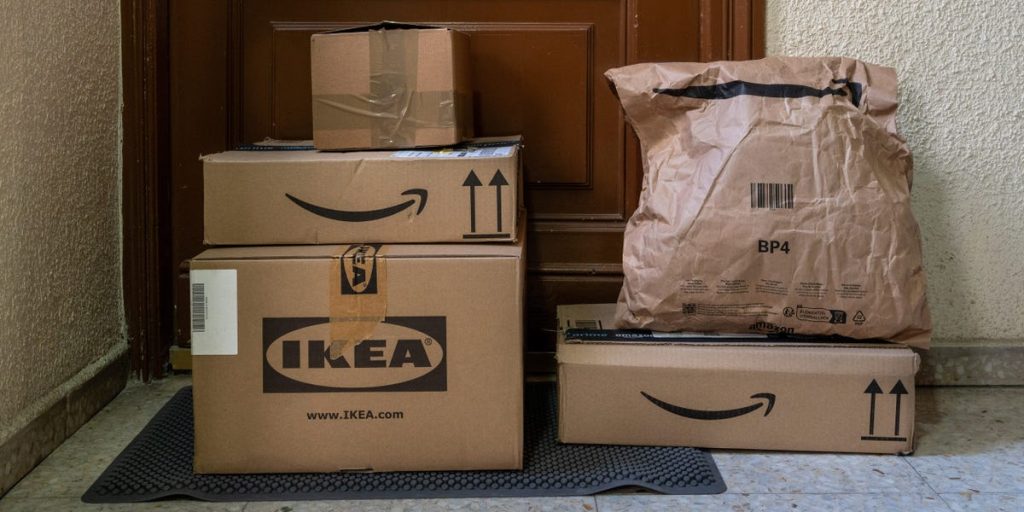- With the Amazon dropshipping model, your business is the forward-facing party customers see.
- Meanwhile, a third party handles the physical logistics.
- You make money by setting a higher price for customers than the price you got from your supplier.
Amazon defines dropshipping as “a fulfillment model that allows entrepreneurs to outsource handling and shipping products to a third party.”
Let’s walk through an imagined example of the process. Say you set up a website that sells handbags, but you aren’t planning on actually keeping pallets laden with bags in your garage or bedroom. Instead, your online store — an Amazon business page, in this case — is where customers browse and place orders.
Once an order for a handbag is placed, you send along the order information and payment to the dropshipper, and that entity (an approved dropshipper, not Amazon itself) handles the fulfillment. Fulfillment is the process of getting the bag out of inventory, packaging it, and physically shipping it off to the customer.
With dropshipping, your business is the forward-facing party that customers see, while a third party handles the physical logistics.
How do you make money by dropshipping?
You profit from dropshipping by setting a higher price for products than the price you negotiate for those goods with your supplier. On your Amazon storefront page, you might charge $25 for a handbag you can buy from your supplier for $15. The margins are yours to set; you know what you’ll have to pay for goods on the backend and can figure out how much customers are willing to spend.
Is dropshipping still allowed on Amazon?
Yes, dropshipping with Amazon is allowed and legal, but there are a lot of rules you need to follow. For example, you must make it clear on all customer-facing materials that you are the seller of record, so any shipping labels, packing slips, and receipts must list your business, not Amazon or the dropshipping partner.
And you are responsible for all aspects of customer service: Amazon’s mighty presence and powerful algorithms can help deliver people to your online storefront, but it’s on you to generate copy, note sales and forward orders along to your shipper, and handle any issues with delivery, product quality, and customer complaints. Amazon is just the conduit, and your dropshipper is just, well, the shipper — the rest is on you.
How much does it cost to start dropshipping at Amazon?
Many Amazon-approved dropship suppliers charge onboarding fees; some have annual membership costs. And some charge a small fee for every sale, so the costs vary widely. Some dropshippers cost nearly $300 to sign up with, and some are free. On the other hand, you will need an Amazon Seller account to dropship with Amazon, and those either cost $39.99 per month for the Professional Plan or 99 cents per item sold for the Individual Plan. You can upgrade (or downgrade) later, of course.
How to dropship on Amazon without money
One of the best things about dropshipping with Amazon is that you can start doing it with little overhead. The cost of the seller account with Amazon may be your only initial expense if you find a dropshipping partner that does not charge a fee. If you plan to grow your Amazon business into a sizeable enterprise, you may want to incorporate as an LLC to shield yourself from legal issues.
What dropshipping suppliers work with Amazon?
Remember, Amazon itself is not the dropshipper. There is a different model, the Amazon Affiliate model, wherein your links on a website or social media platform send customers right to Amazon, and you get a cut of subsequent sales. Here, Amazon connects you to customers and then steps back. When you get an order paid for, you buy the item from your supplier and have them ship it to your customer.
The best Amazon dropshipping suppliers right now include Wholesale2B, Inventory Source, Banggood, and CJ Dropshipping, to name just a few — a quick search easily turns up many more.
Do Amazon dropshippers make money?
You can indeed make money dropshipping via Amazon, and in some cases, you can make many thousands of dollars every month. But take note: the average profit margin for dropshippers is 15%. At the lower end, you might make eight percent, and at the highest, 30%, according to BeProfit, but let’s look at that 15%. At that rate, if your handbags sell for $25, after all your expenses, you’d make $3.75 for each sale. That means you’d need to sell 267 bags before you’d break the $1,000 threshold in profits. It’s doable, but it can be a slog.
Do I have to buy inventory for Amazon dropshipping?
The best thing about dropshipping is arguably the limited startup cost and minimal ongoing investment of capital needed, but a close second is the fact that, in most cases, you don’t need to pre-buy any inventory. There are business models like Fulfillment by Amazon where you do pre-buy inventory and have it stored at the ready in Amazon warehouses, but in the classic dropshipping model, you do not need to have the product pre-purchased.
As an Amazon seller, you just need to be ready to reach out to your supplier on the double once those orders come in because people have very little patience for long shipping times these days — and we have Amazon to thank for that.
Read the full article here





